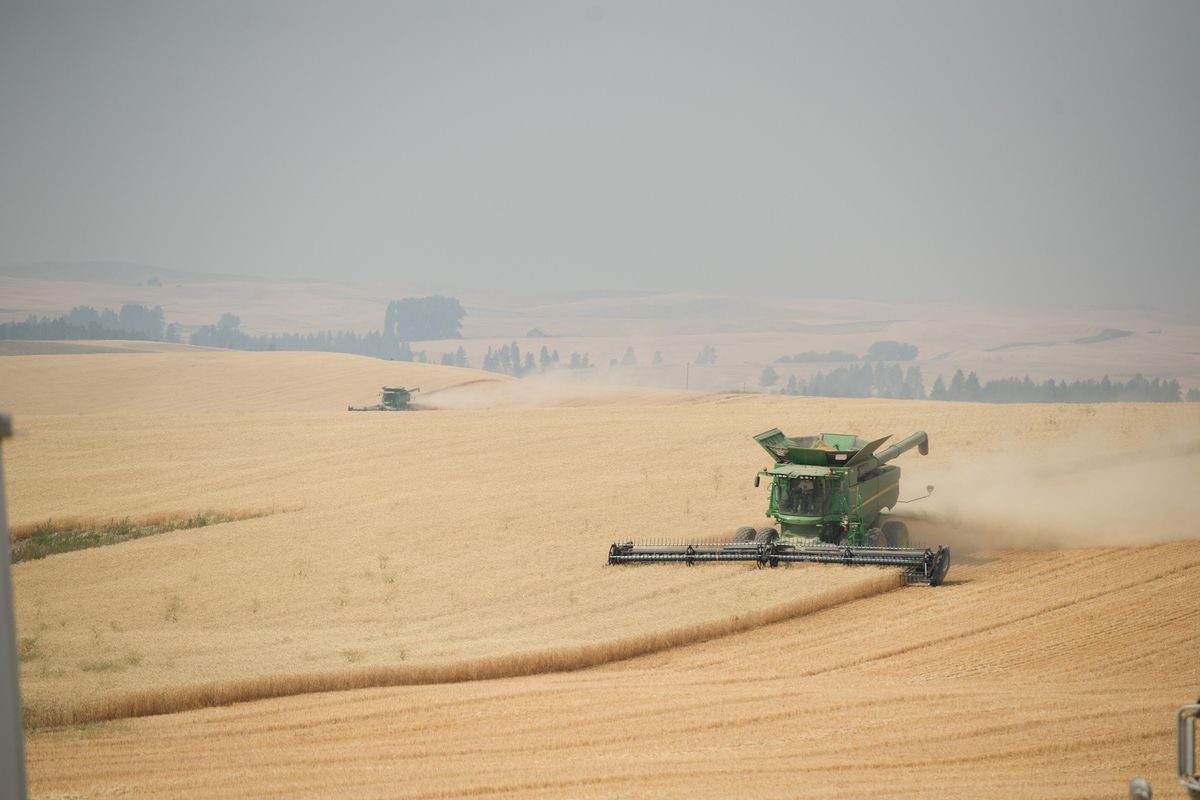
Wet spring and summer’s heat deliver mixed wheat harvest
It takes about 20 minutes for the Green family to harvest a load of wheat, shuttle it across their sprawling farm northwest of Fairfield and deposit the grain into large storage bins on their property.
On Wednesday, the process involved two massive John Deere combines and two long tractor-trailers. Jordan Green and Mark Giese piloted the combines, while Lonnie Green, Jordan’s father, climbed in and out of both trucks, making frequent trips between the field and the storage bins.
They usually have another helping hand. Lonnie’s younger son, Derek, who recently returned to classes at the University of Idaho, drives a “bank-out” wagon alongside each of the combines, allowing them to empty their grain hoppers while still in motion – similar to the way a tanker from Fairchild Air Force Base refuels other airborne planes.
Most years, the family can harvest through the month of August with few interruptions, said Marci Green, the vice president of the Washington Association of Wheat Growers and Lonnie’s wife.
But this year’s harvest has been more sporadic, she said. A protracted rainy season was followed by persistent heat topping 100 degrees, resulting in a low yield of spring wheat and a so-so crop of soft white winter wheat.
“What’s been strange this year is that different crops have been getting ripe at different times,” she said. “We’d harvest for four, five days and then wait for other fields to get ripe.”
Scott Yates, a spokesman for the Washington Grain Commission, said this year’s harvest, overall, will be “better than average,” even though some wheat fields on the Palouse may have received too much rain.
“You hardly ever run into that problem,” Yates said.
The good news is that Washington wheat farmers have avoided another plague of low “falling numbers,” said Michelle Hennings, the executive director of the wheat growers association.

Falling numbers are a measure of grain quality that reflect the presence of an enzyme that degrades starches. Last year’s numbers were driven downward by unusual weather fluctuations and contributed to economic losses in the tens of millions of dollars, according to Washington State University and U.S. Department of Agriculture researchers.
“Fortunately in 2017, nature dealt the region some kindness and the widespread low falling numbers of 2016 were a rare event,” reads a recent post on the university’s Small Grains website.

Nationwide wheat crop at historic low
Many wheat farmers still are struggling to break even because of a global grain surplus that has been driving down prices for years. The average price per bushel in Portland tumbled from more than $8 in 2012 to about $4.20 last year. It’s now hovering around $5.
“Our expenses really don’t pencil out,” Lonnie Green said. “We’re still about $20 an acre short.”
That surplus has led farmers across the Midwest to grow less wheat and opt for crops such as lentils and chickpeas, which are suddenly in demand because of the surging popularity of foods such as hummus.

This year’s wheat crop of 45.7 million acres nationwide is the smallest since the U.S. Department of Agriculture began keeping records in 1919.
Acres planted to chickpeas are at 603,000 this year, up nearly 86 percent from last year, according to the USDA. Meanwhile, lentils have reached a U.S. record high of 1.02 million acres planted. Lentils are increasingly used to boost protein and fiber content in cereals, energy bars, chips and pasta.
Washington’s wheat acreage has remained relatively flat, according to the USDA. Farmers in the state have grown lentils for years, but chickpeas are becoming more common here, too.
Marci Green said about half of her family’s farm is planted to bluegrass and about 40 percent to spring and winter wheat. In addition to their usual lentil rotation, the family also is harvesting chickpeas for the first time in several years, she said.

The Associated Press contributed to this report.